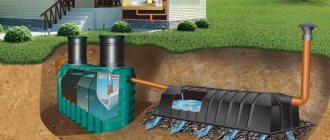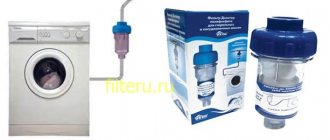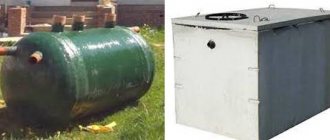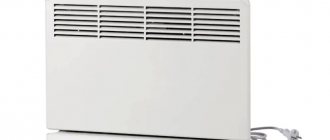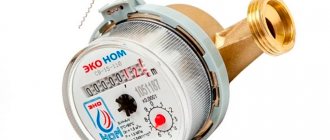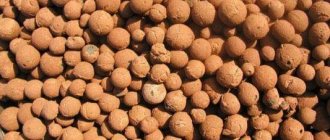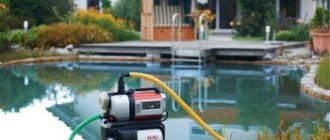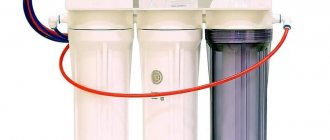In the private sector, there are often situations when there is a centralized water supply system, but there is no sewerage system. In order to use all the necessary plumbing fixtures without problems, you need to take care of drainage and wastewater treatment.
The task becomes more complicated if aquifers are located close to the surface. A solution to the problem can be a septic tank for high groundwater - the device is selected based on an assessment of the geological condition of the site and the expected intensity of operation.
The influence of high water on the functioning of an autonomous sewer system
At what depth the groundwater is located on the site, it is necessary to find out before designing the house sewer system and choosing a septic tank. This is one of the main factors that cannot be ignored. Otherwise, big troubles and large expenses are possible:
- An increase in water level above the tank installation level can cause partial or complete flooding of the septic tank and, as a result, the release of sewage to the outside.
- The slightest leak is fraught with contamination of groundwater and the entry of waste into the fertile soil layer and sources of drinking water.
The slightest disruption to the normal operation of the sewer system in such problem areas means not only additional large costs for its reconstruction, but also a high risk of bacterial contamination of a large area of soil. Which will lead to a persistent unpleasant odor, intestinal infections and other problems.
Flooding of a septic tank is a big problem Source rotoplast.ru
Industrial production models
Numerous reviews allow us to identify three current septic tanks for drainage near groundwater. This:
- Septic tank called "Tank"
from the manufacturer Triton Plastic. The model is made of plastic, has three sections in the body, where in the first two cleaning is carried out by overflowing and settling the contents, and in the third section anaerobic bacteria come into play.
- "Mole"
. It is produced by the Aqua-Master company. This option is better suited for installation with water-water treatment, since the hull is initially protected from floating, and the design implies the presence of a biofilter.
- Septic tank Bioton B
. This option of a septic tank is considered the most relevant for working with a close water supply system. Its design not only includes a biofilter, but also has a three-section structure. In one of the sections you can place a sewage pump to pump out liquid. Biton B involves constructing a pit with a slope from the perimeter.
Definition of groundwater level
Water in the soil is never at one constant level - it changes depending on the time of year and the amount of precipitation. These seasonal fluctuations lead to the fact that in the spring, during the period of snow melting and flooding, groundwater comes closest to the surface of the earth, and during summer drought and winter frosts it drops lower. Therefore, it is necessary to determine the level at certain moments.
Graph of groundwater level changes by month in different years depending on weather conditions Source konspekta.net
When determining which septic tank to choose for a private house with high groundwater, the groundwater level is measured at the peak of the rise. If you need to equip a cottage with seasonal residence only during the warm summer months, it is enough to take into account the maximum level for this period.
As a rule, the depth of the aquifer is determined at the stage of designing or laying the foundation of a house. But if you decide to modernize an old dacha or a purchased house without communications, you will have to do it yourself or you can ask your neighbors.
To do this, a well is drilled at a site more than 2 meters deep, and in the “high” season, using an ordinary rope with a weight, they measure how far the water is from the surface. The level is considered high if this distance is less than 1.8-2 m.
It happens that no measurements are required - in some areas groundwater appears on the surface of the earth in the spring. In such situations, it is necessary to install a drainage system, since on swampy soil it will be difficult not only to improve the house, but also to grow vegetables and fruit trees.
An area with a high groundwater level is visible to the naked eye Source kamskoe-ustie.ru
Choosing a septic tank
We can say for sure that if the groundwater level is high, a storage septic tank or a septic tank biological treatment station is suitable.
It is important! A septic tank made of concrete rings and an overflow septic tank will not work, because... a concrete septic tank is not airtight, and an overflow septic tank has a 60-70% degree of wastewater treatment, which will lead to bacterial contamination of a large area of soil, as a result of which there will be a persistent unpleasant odor in this place!
It is impossible to say for sure which septic tank is better if the groundwater level is high. To do this, you need to know the expected operating conditions:
- seasonal or permanent use;
- volume of wastewater for a certain period of time;
- type of soil, its filtering properties and degree of frost heaving;
- relief of the site;
- the presence of reservoirs and artificial sources of drinking water nearby.
In any case, the drainage container must be airtight and have very strong walls to withstand the backwater of water and soil pressure without deforming or collapsing.
By design, a septic tank can be a simple storage tank or a factory-made deep cleaning station.
Recommended types of septic tanks for high groundwater levels
When underground waters are close, in addition to the lateral pressure of the soil, the tank is affected by the backwater of water, and in winter also by the forces of frost heaving. Therefore, the walls of the structure must be strong and airtight. This can be provided by both factory models and construction-ready septic tanks.
Factory drive
The simplest and most cost-effective option for installing an autonomous sewer system in a country house or house for non-permanent residence is a storage septic tank. It is like a sealed cesspool or drainage pit. Wastewater flows through the supply pipe directly into the tank, from where, after filling, it is pumped out by a sewer truck.
Factory drives are made primarily of plastic. At high groundwater levels, polypropylene or fiberglass septic tanks are preferable, since products made of low-density polyethylene are not rigid enough and can fail due to frosty soil movements.
The containers are installed in the pit manually or using a lifting mechanism. The layout is preferable to a horizontal one, in which there is no need to dig a deep pit. This creates a lower groundwater pressure both during installation and operation.
In addition to ease of manufacture and installation, factory drives have the following advantages:
- complete tightness, no leaks;
- suitable for areas even with very high groundwater level;
- does not depend on power supply;
- meets the requirements of sanitary standards;
- affordable price.
Containers can be used not only temporarily, but also permanently. Free access for sewage disposal must be provided.
Made from reinforced concrete rings
Septic tanks made of reinforced concrete rings are very popular. To assemble the structure, products with a diameter of 1-2 meters and a height of 90 cm are used. Each element is installed on the previous one and secured with brackets. The seams are carefully sealed with waterproofing materials.
Concrete septic tanks can operate in 2 modes:
- gravity;
- with drain pump.
Since concrete is a permeable material, it is recommended to install a prefabricated septic tank when the groundwater level is no higher than 130 cm. In this case, it will operate normally.
The storage tanks are installed in series in the amount of 2-3 pieces and connected by overflow pipes. In the first chamber, sedimentation of solid particles occurs, in the second and third, biological breakdown by bacteria of various types.
Due to the insufficient degree of purification, clarified wastewater cannot be discharged onto the terrain. Further processing is carried out by filter fields, trenches, wells or infiltrators.
Advantages of septic tanks made of concrete rings:
- high strength, allowing to withstand lateral soil pressure and frost heaving without any deformation;
- no or very low power consumption;
- long service life.
Deep biological treatment station
A more technologically advanced method of wastewater clarification is SGBO, in which water is purified up to 98%. For areas with high groundwater level with permanent family residence, this is a convenient option that eliminates the labor-intensive installation of filtration fields.
The station is a multi-chamber (3 to 5) container with compartments designed for a specific type of cleaning:
- mechanical clarification zone, where solid particles precipitate, grease and films are retained;
- anaerobic fermentation chamber, in which biological processes take place without access to oxygen;
- zone of aerobic oxidation in the presence of oxygen and bioenzymes.
Biotreatment stations are equipped with drainage pumps, compressors, valves, airlifts and other devices that consume energy. The water obtained after purification can be used for technical purposes. The equipment is operated for a long time without pumping, maintenance is required once every 3 years.
Drives
The simplest, most reliable and budget option for a summer cottage is a septic tank. It is also suitable for houses with a small number of residents and a minimum set of water-consuming equipment.
The principle of operation of the storage facility: it collects all waste into one chamber, followed by pumping out by a sewer truck.
Choosing a storage tank by volume is very simple (for example: if you spend 100 liters of water per day, then a 3000 liter storage tank will last you for 1 month).
For reference! The sewer truck can pump out 4000 liters at a time.
A storage tank is a large-volume sealed container for collecting wastewater, which, when filled, is emptied by sewage disposal equipment.
Septic tank - installation diagram Source polik.kz
What are the advantages of this option:
- ease of maintenance (except for odors during pumping);
- possibility of operation at very high groundwater levels (here it is important that the storage tank is anchored and sprinkled with sand and cement in a ratio of 1:5);
- independence from power sources.
The disadvantages of this option include:
- The need for frequent pumping of the container with a sewage disposal machine.
- Availability of always free access roads (since a car cannot drive everywhere).
- Regular costs for calling a vacuum cleaner.
- Odor during pumping.
- Very difficult installation at high groundwater levels. Therefore, the cost can be very expensive considering the concrete slab, cement, etc.).
Note! Drives can be homemade or factory-made.
The first are constructed from concrete rings or welded metal containers.
The disadvantages of such homemade septic tanks are that concrete rings or metal containers will begin to leak groundwater due to their leakage.
Factory septic tanks are made from steel and polymer materials. To add strength and rigidity, plastic containers are made with ribbed walls. Their main advantage over homemade ones is absolute tightness, including the entry points of sewer and ventilation pipes.
One of the models of a factory sewage storage tank Source plastikoviy-septik.ru
Advice! If the groundwater level is very high and the soil is clayey, preference should be given to horizontal septic tanks made of fiberglass or polypropylene with a wall thickness of more than 1 cm and high-quality material (without the addition of recyclable materials) - these materials have sufficient strength and maintain integrity when the soil moves under the influence of frost heaving. And the horizontal arrangement allows you to reduce the installation depth without losing storage capacity.
Biological treatment stations
The most reliable option for permanent residence in a house or even a summer cottage with seasonal accommodation.
Operating principle of a septic tank station:
From the sewerage system, wastewater goes into a septic tank, which purifies it up to 98% (including toilet paper and similar impurities that decompose). A septic tank uses a multi-stage cleaning mechanism, which includes mechanical, biological and chemical effects on the wastewater entering it. A separate advantage of the device is that its operation is based on the natural processes of decomposition by microorganisms under aerobic and anaerobic conditions.
The first chamber of the septic tank provides mechanical cleaning - non-recyclable particles (sand, paper, hairballs, etc.) settle here.
The next stage is an aerobic bioreactor, in which microorganisms living in an oxygen environment “work.” They oxidize organic matter.
In the next settling tank, activated sludge is separated from the water and settles to the bottom of the tank. The water, in turn, goes into a bioreactor in which anaerobic bacteria live (“working” in an oxygen-free environment).
The last stage is the final settling tank, after which the completely purified water is removed from the septic tank.
The output is practically pure, “technical” water, which can even be used to water crops.
Which exit?
And the solution is very simple. You just need to use the septic tank installation service provided by Eco-Bio . This will allow you:
- Count on our specialists if problems arise with your septic tank.
- Don't worry about installation correctly. We'll do great - as good as we can do.
- Use a septic tank for a long time. It will work as efficiently and reliably as possible.
- Avoid penalties.
How to choose a septic tank station
According to SanPin standards, water consumption per person per day is calculated at 200 liters.
For example: 5 people live permanently, 5 × 200 liters equals 1000 liters or 1 cubic meter of water – i.e. the processing volume of a septic tank station must be at least 1 cubic meter/day.
There is also an important indicator - the volume of the septic tank station itself - it is calculated as 500 liters per person. Those. for 5 people, the septic tank must have a volume of at least 2500 liters.) If the volume of the septic tank is smaller, then it simply will not cope with the processing of household household goods. household wastewater - the degree of purification and other troubles will be reduced.
All characteristics of biological treatment stations are included in the description of each manufacturer.
See also: Catalog of companies that specialize in the design and installation of sewerage and water supply
Features of horizontal stations
When choosing a biological treatment station, you need to pay attention to its design - there are horizontal and vertical ones - it depends on the location of their chambers.
The horizontal design of the biological treatment station is less demanding to operate. Next, let's look at their advantages using an example.
First of all, let's consider those that affect the comfort of use:
- No blockages.
There are no blockages in horizontal septic tanks, since they do not have airlifts. The drains flow by gravity into the primary chamber through a pipe with a diameter of 110 mm and these dimensions are more than enough for their free movement.
Explanation! The airlift, which is an integral part of vertical septic tanks, is a tube with a diameter of 2 cm through which wastewater flows from chamber to chamber. Since the diameter of the tubes is small, there is a constant risk of them becoming clogged with unprocessed particles and they need regular cleaning - from 2 to 4 times a year.
- Reliability.
Due to the design features of a horizontal septic tank. First of all, this is the absence of complex electronics and metal parts. The design is as simple as possible and there is simply nothing to break in it.
The second factor is the use of high-quality frost-resistant plastic, which must undergo hydrodynamic tests. Only its warranty period can be up to five years (this is the type of plastic used)
Few moving parts, for example, a compressor, are reliable devices that have been proven by many years of practice and are capable of ensuring the efficient operation of a biotreatment station.
As a result, we get the service life of such a septic tank in the region of 60 years or more.
- Autonomy and safety.
Since the device is completely sealed, it does not emit any odors. And the only maintenance it will need is removal of the processed sludge. At the same time, the latter can be used as fertilizer, and its extraction can be done with a conventional drainage pump.
- Energy independence.
The most common “reproach” against biorefinery stations is that during power outages they stop working. However, this only applies to vertical devices. And horizontal ones, when the power is turned off, simply begin to work like a classic overflow septic tank. In fairness, it should be noted that constant operation in this mode is undesirable, but not very long interruptions in the power supply to the septic tank are not terrible.
On a note! A horizontal biorefinery station can operate for up to 2 days without electricity.
- Does not require conservation in the absence of operation.
That is, it is suitable for both permanent and seasonal residence.
- Clear and easy to install.
The purchased station already has factory connections for incoming and outgoing sewer pipes, which eliminates the risk of incorrect installation. Of course, the manufacturer includes detailed instructions in case you want to install the station yourself.
- The “Pro Bio” biological treatment station, due to its horizontal design, does not require much penetration into the ground.
That is, it is excellent for areas with high groundwater level, plus, the shallower the depth, the lower the cost of excavation work.
- If the groundwater level is high, the biological treatment station does not need to be anchored!
Since the station always stands filled with water (in contrast to the storage tank, which stands empty after pumping out), and “water does not squeeze out water (that is, groundwater and water in the station have a uniform density and “homogeneous bodies do not squeeze out each other, according to the laws physics), installation of a station is cheaper than a storage device.
- Purified water up to 98% (technical, like rainwater) goes into a drainage well, a filtration field (which does not lead to bacterial contamination, no odors) or a ditch.
If the groundwater is high, then the purified water is removed using a drainage pump (due to this, groundwater does not enter the septic tank).
One of the designs of SGBO Source septic tank-52.rf
Number and purpose of cameras in the station:
- A receiving compartment is available in all stations; mechanical separation of wastewater into solid particles, greasy films and clarified liquid occurs in it.
- The clarified liquid flows by gravity into the next chamber.
- This may be a forced air aeration chamber in which biological decay processes occur with the participation of enzymes and aerobic bacteria.
- Some gas storage facilities have sealed compartments with anaerobic bacteria that process waste without oxygen.
- The last to be placed are settling tanks, in which the purified water is finally clarified and goes into a drainage well or filtration or ditch by gravity or using a drainage pump (due to this, groundwater does not enter the septic tank).
5-chamber septic tank for a residential building Source yandex.net
Such installations operate on electricity - a compressor (supplies air for aeration and a drainage pump for pumping out purified water). Consumption is about 1 kW per day.
When there is a power outage, the station with forced release of purified water can receive up to 300 liters of water.
And if the purified water comes out by gravity, then you can use it as usual.
Important! There is no need to be afraid of the power dependence of the station, because We are not afraid, for example, of the refrigerator (it produces cold for us so that the food does not spoil), and the station recycles household goods. household waste)
Biological treatment stations are reliable and easy to use, with a high degree of wastewater treatment. What is important for permanent residence households.
Pumping out unprocessed silt deposits from such septic tanks is required much less frequently than from conventional storage tanks. Moreover, they can be used to prepare compost for fertilizing garden plantings. And large volumes of technical water allow you to save on irrigation.
Overflow tanks with filtration structures
When the groundwater lies deep, an overflow septic tank (a container divided into compartments) can be installed for the dacha.
Important! Such devices are suitable only for areas with low groundwater and for non-permanent residence.
Principle of operation
The first two sections of the septic tank are needed in order to stratify the primary wastewater into fractions:
- the lightest fractions float to the surface;
- fractions that are heavier than water settle to the bottom of the container and are then removed when the septic tank is pumped out with a sewer machine);
- everything else is poured into the next chamber as the septic tank fills;
- from the last chamber, untreated water must flow into a drainage well or filtration field for further soil purification because The wastewater in such septic tanks is purified up to 60-70% - it has odors and contains other impurities.
Based on the latter, this option does not work at high groundwater levels, since untreated wastewater can enter groundwater and lead to its contamination and the entry of wastewater into the fertile soil layer and sources of drinking water.
How to choose an overflow septic tank
Calculate 500 liters per person, i.e. for 5 people, the overflow septic tank must have a volume of at least 2500 liters.
Advantages of contacting
provides high-quality installation, maintenance and repair services for various types of septic tanks on the most favorable terms. All work is carried out by highly qualified specialists with relevant specialization and many years of experience.
Prices for reinstalling a septic tank in our company are the lowest in the area, and therefore affordable for every consumer. We are always ready to help in difficult situations, providing a whole range of services. Moreover, only we provide a 100% guarantee after installing a septic tank , i.e. recurrence of any accidents is excluded. You can also sign a contract for septic tank maintenance and use part of our services absolutely free.
find out the cost of reinstalling a septic tank after surfacing by calling our operator at the specified telephone number or dialing the phone number of a septic tank repair specialist from, as well as downloading the price list on the website.
Feel free to contact us! We guarantee that your problem will be resolved promptly, with truly high quality and in the shortest possible time!
Did you like the article? – click on the social network buttons!
0
- Back
- Forward
Types of additional filtration structures
If the groundwater level is high, the usual filtration fields must be raised above the groundwater level.
Which is better for high groundwater depends on its level, the duration of the rise to the maximum level and the availability of free space on the site. This may be a drainage well, a tunnel or an embankment.
- Filter well.
It is built from reinforced concrete rings and installed at a distance of 2-2.5 meters from the septic tank. If groundwater reaches the surface of the earth during a seasonal rise, the well is placed on an embankment of filtering materials about 30 cm high. The same layer of drainage cushion is made when deepening the well, but its bottom in any case should be above the groundwater level.
Three-chamber septic tank with a filter well Source vanna.by
The well has no bottom, and cracks or holes are made in its walls to allow clarified waste to flow into a filter layer of crushed stone, with which the structure is filled up to half its height. Geotextiles are laid on the crushed stone, and then the well is insulated, making an embankment of soil to the very top. It is closed with a hatch with a ventilation riser leading outside.
- Drainage tunnel.
Drainage tunnels (infiltrators) are plastic trays with stiffening ribs and inlet holes at the ends for installation of supply pipes. They are installed on the filter pad with the open part down.
Video description
This video shows the process of installing infiltrators:
But in the case of high groundwater, the pit for them is not torn off, but only the fertile layer is removed from the ground and the resulting trench is filled with crushed stone. The tunnel, installed and connected to the septic tank, is covered with geotextile and a high embankment of soil is made above it, through which a pipe is drawn for the flow of air, the presence of which is necessary for the breakdown of organic matter.
Note! The number and total volume of infiltrators depends on the volume of wastewater and soil permeability and is calculated individually.
- Filter embankment.
This structure is an analogue of filtration fields buried in the ground, which are installed when the groundwater level is low. But in this case, drainage dispersive pipes are placed in an embankment of crushed stone, and the contents of the septic tank enter them not by gravity, but by force, by pumping.
As in the case of the structures already described, the filter embankment is covered with geotextile to prevent siltation, insulated with a layer of soil and a ventilation pipe is removed. This structure works even in wetlands if the crushed stone layer is laid on an embankment about 1 m high.
Required tools and materials
Below we will consider in more detail the process of installing a storage sump. For self-installation you will need the following tools:
- motor pump;
- shovels;
- metal cable;
- building level;
- jigsaw
You need to prepare the following materials:
- wooden or metal tongue and groove;
- boards for formwork, AIII reinforcement Ø12 mm, B12.5 concrete (with a monolithic foundation) or prefabricated reinforced concrete slab;
- clamps for attaching the container to the base;
- sealant.
Installation Features
Having decided which septic tank is best for a private house with a high groundwater level in your case, you can proceed to design and installation. But first you need to choose a place to locate the treatment plant.
Selecting a location
When determining the location of the septic tank, take into account the following requirements:
- For a storage septic tank and an overflow septic tank, we choose a place so that a sewer truck can drive up.
- For an overflow septic tank, we choose a place so that the distance from it to any source of water, including the neighbor’s, is 25 m or more.
- For a biological treatment station, because technical water comes out, the distance to the water source can be reduced.
- It is better to keep the distance to the house minimal, but not less than 5 m.
- The distance from the fence and electric poles is 2-5 meters.
The closer the septic tank is located to the exit from the house, the higher the entry into it will be Source eurobion.info
- to make the route as short as possible, the septic tank is placed against the wall of the house behind which the kitchen and bathroom are located;
- You should try to remove the pipe from the house as high as possible, burying it no more than 50 cm into the ground;
- if other buildings are planned on the site, it is necessary to provide for their connection to the septic tank and the possibility of access to it by a sewer truck;
- To eliminate the risk of flooding by melt and flood waters, the container should not be placed in lowlands.
Determining the depth of groundwater
You know about the problems that arise with high groundwater level. The next step is to determine the depth of groundwater in your own area.
Groundwater levels may vary throughout the year
You may be interested in information - septic tank fast
The list shows three ways to do this, listed in order of increasing difficulty:
- survey of neighbors;
- search for indicator plants;
- drilling of exploration wells.
The first way to determine the water level is the simplest - you need to walk through nearby landscaped areas and interview residents. Among them there will probably be those who have independently built and installed sewer systems, and they can share useful information with you. But it should be understood that this method is not very accurate and is only suitable for a very rough estimate of groundwater level.
The presence of wetlands and flooded areas on the site is a clear indication of a high groundwater level or the presence of clay soils with poor drainage characteristics
The second way is to evaluate what grows on your site and in the surrounding area. Plants are a kind of indicators that allow us to draw approximate conclusions about the groundwater level. If the flora in the area is predominantly moisture-loving, then most likely the groundwater level here is high. For a more precise determination, use the table.
You might be interested in the information-system ball
Table. Indicator plants indicating the groundwater level in the area.
| Approximate groundwater level, m | Indicator plants |
| From 0 to 0.5 | Sedge, cattail, reed, Langsdorff's reed grass, marsh wild rosemary, downy birch |
| From 0.5 to 1 | Canary grass, meadowsweet, cattail, reed, |
| From 1 to 1.5 | Sandy rush, spruce, heather, blackberry, mouse pea, white bentgrass, meadow rank and fescue |
| From 1.5 and deeper | Yellow alfalfa, naked licorice, chi, meadow clover, awnless brome, plantain, creeping wheatgrass, juniper, moss, lingonberry |
An example of the dependence of vegetation on groundwater level
The third method is the most accurate, but at the same time the most labor-intensive. Let's present it in the form of step-by-step instructions.
You may be interested in information: do-it-yourself septic tank made from plastic barrels
Step 1. Prepare a drill with a length of at least 2 m. If necessary, you can use a tool with a greater drilling depth.
Step 2. Identify several locations on the site for wells. It is advisable that one of them be located where the installation of a septic tank and treatment systems is planned.
Step 3. Drill a hole 2 m or more deep.
Well drilling
Step 4. Wait a day. To be safe, cover the tops of the wells with waterproof material so that overnight rain does not interfere with the determination of groundwater level.
Finished well
Step 5. Prepare a metal pin or wooden stick for the depth of the well. Place marks on its bottom every 10 cm.
You may be interested in information about how to install a septic tank at your dacha with your own hands
Step 6. Immerse this “indicator” into the well and pull it out. Determine the length of the pin that was wet and determine the groundwater level. As an example: a well was dug 2 m deep, the pin turned out to be 30 cm wet. Perform simple calculations: 200 – 30 = 170 , therefore, the groundwater level in this place is 1.7 m.
Groundwater measurement
Step 7. Wipe the “indicator” or let it dry and repeat the experiment with other wells on the site.
Step 8. Repeat steps 6 and 7 with all wells for three days to obtain a more or less accurate result.
Another marker of the groundwater level in the area can be a well
Important! It is best to take measurements in the spring, after the snow melts, when groundwater rises to its maximum. If waiting until March or April is too long, try the experiment in the summer or fall after several days of heavy rainfall.
Video description
Features of installing a biological treatment station in wetlands are the topic of the following video:
The most common mistake when installing septic tanks is failure to follow the rules for backfilling. It is done sequentially: fill 1/3 with sand, fill 1/3 with water, etc.
- Firstly, this is necessary for the final shrinkage of the structure under its own weight.
- And secondly, if you leave the container empty and do not fill it with water, at high groundwater levels it may float
Failure to comply with this requirement often leads to depressurization of pipe connections and inlet pipes.
The drain pipe from the house is laid in a trench, the bottom of which is covered with sand. Before equipping the entrance to the septic tank, check its slope, which should be 2-3 degrees. Changing it in any direction changes the flow rate of the wastewater, which is why solid inclusions can linger in the pipe and form blockages.
It is very important to maintain the slope of the sewer line Source aquaterem.com
Pipes are also first backfilled with sand to prevent soil pressure on them, which increases in volume as it freezes.
Features of installation with close underground waters
To prevent the infiltration of contaminated wastewater both inside and outside, the storage tank must be absolutely sealed. The best choice for waterlogged soils is a septic tank made of polymers - polypropylene, polyethylene or fiberglass. The walls must be thick enough, and the structures must have stiffening ribs to withstand heavy loads.
Installation stages
Installing a septic tank under standard conditions includes the following steps:
- Digging a pit.
- Sand cushion installation.
- Immersion and leveling of the container.
- Laying sewer pipes.
- Filling the structure with water.
- Condition check, commissioning.
- Backfill with layer-by-layer compaction.
Features of installation in close water
At high groundwater levels, work differs from usual in a number of nuances:
- Groundwater can flow in large quantities. You need to stock up on a drainage pump for pumping.
- It is advisable to choose a horizontal layout of the septic tank in order to raise the bottom of the pit as high as possible.
- If the slopes crumble, install retaining walls made of boards or panels.
- To secure the container, a reinforced concrete slab with outlets is placed in the pit or a reinforced concrete cushion is installed with anchors made of reinforcement. After immersing the septic tank, it must be secured with steel slings so that the installation does not float when lifting the water supply system. This is especially true for lightweight plastic structures and metal caissons.
- Sewer and overflow pipes, connecting elements, and drainage field must be raised as high as possible. If they are even periodically under water, the system will overflow and will not work.
- The neck of the structure is raised to a height of up to 30 cm above ground level, and an insulated blind area is installed around it.
- The joints in a prefabricated septic tank made of reinforced concrete rings are carefully sealed with waterproofing mixtures.
Popular septic tank models
If a storage tank, overflow septic tank or biological treatment station is chosen for the collection and disposal of household waste, the main criteria for their selection should be strength and tightness, wall thickness, high-quality components, as well as the volume required for your family.
Horizontal biological treatment stations “Pro Bio” from production Source probioseptik.ru
Such septic tanks are produced by leading domestic manufacturers; in each line you can find a model that meets your requirements.
The most reliable and effective biological treatment stations, judging by the reviews and popularity of consumers, are equipment from the following brands:
Horizontal version
- "Pro Bio"
- "Tver"
Vertical version
- "Topas"
- "Unilos"
We wrote above about the advantage of horizontal biological treatment stations over vertical ones.
Installed Pro Bio purification station Source probioseptik.ru
Briefly about the main thing
Groundwater lying close to the surface creates many problems when installing an autonomous sewer system. But they are completely solvable with the right choice of septic tank. For a small dacha with seasonal living, the best choice would be a storage tank that is pumped out 1-2 times per season. For a private home equipped with a full set of sanitary and household appliances, a deep biological treatment station is more suitable, from which practically pure water can be thrown onto the terrain or used for technical needs.
If the groundwater level is low and the area of the plot allows, for a summer residence or non-permanent residence you can save money and instead of an expensive station, install an overflow septic tank with additional drainage structures.
And if you don’t have problems with groundwater on your site, it’s low, then you can safely choose any septic tank to suit your needs!
Ratings 0
Our works
October 4, 2019
Maintenance and cleaning of septic tank Tver
Moscow region Odintsovo district village.
Podlipki May 11, 2019
Installation of a septic tank Tver 0.85 PN
Turnkey septic tank installation in Ozersky district.
Object - Moscow Region, Ozersky district, Ledovo village, SNT Ledovo October 27, 2018
Installation of septic tank Tver in Bronnitsy
Tver-0.5PN, installation Ramensky district, Bronnitsy, Nikonovskoye joint venture October 27, 2021
Installation of a septic tank in the village of Ledovo, Tver
Installation of a septic tank in the village of Ledovo, SNT Ledovo, Tver
Dismantling the skeptic Odintsovo district, Nikolina Gora, Uponor Sako
Dismantling the skeptic Odintsovo district, Nikolina Gora, Uponor Sako
